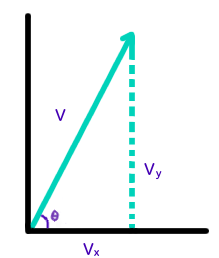A projectile is shot at an angle of #pi/8 # and a velocity of # 10 m/s#. How far away will the projectile land?
2 Answers
Explanation:
Simply use the formula
Explanation:
The other answer is correct, but I will include a further explanation in case it is valuable to the OP.
We can use kinematics and vector decomposition to calculate the range of the projectile.
We are given the following information:
-
#|->v_i=10" m"//"s"# -
#|->theta=pi/8#
To calculate the horizontal distance the projectile follows, we can use the following kinematic equation:
#Deltax=v_(ix)Deltat+1/2a_xDeltat^2#
We assume gravity is the only force acting on the projectile (e.g. no air resistance). Because the projectile is only under the influence of gravity, it has a constant vertical acceleration of
#color(purple)(Deltax=v_(ix)Deltat)#
Which we are likely used to seeing as
We will need both the parallel (x) component of the velocity and the the total flight time of the projectile. We will have to use the vertical components to find the flight time.
As mentioned above, the vertical acceleration is
A convenient fact is that, provided the object lands at the same altitude it was launched from,
We can use the following kinematic equation to find
#cancel(v_(yf))=v_(yi)+a_yDeltat#
#=>Deltat=(-v_(yi))/(a)#
We will now find the parallel (x) and perpendicular (y) components of the velocity.
Here is a diagram for the first (initial) velocity vector,
Using trigonometry, we see that:
#sin(theta)="opposite"/"hypotenuse"#
#=>sin(theta)=v_y/v#
#=>color(crimson)(v_y=vsin(theta))#
Similarly, we find that
So, we have:
#v_y=10sin(pi/8)#
#color(skyblue)(~~3.827" m"//"s")#
#v_x=10cos(pi/8)#
#color(skyblue)(~~9.239" m"//"s")#
We can now solve for
#Deltat=(-v_(yi))/(a)#
#=(-3.827" m"//"s")/(-9.8" m"//"s"^2)#
#=0.391"s"#
Therefore, the total flight time is
Revisiting our first kinematic for the range...
#Deltax=v_(ix)Deltat#
#=(9.239"m"//"s")(0.782"s")#
#=7.224"m"#
#~~7"m"#



